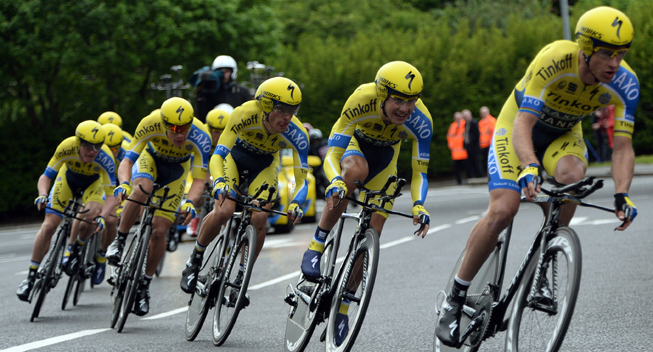With no sprinter on their roster, Tinkoff-Saxo had nothing to win in today's dangerous fourth stage of the Giro d'Italia. Hence, the team fully supported the decision to neutralize the race as they deemed the conditions to dangerous for a bike race.
Stage 4 in Giro d’Italia took the riders 112 kilometers from Giovinazzo to Bari in southern Italy. But despite the usual sunny weather, the region of Puglia showed itself from its most rainy and slippery side. The race was neutralized during much of the stage and the race jury took the decision to neutralize the last lap of the stage. The result was that almost no riders lost time on the stage and Tinkoff-Saxo managed to avoid any disruptive crashes.
But what actually happens in the peloton and DS cars as the rain starts to pour creating a dangerous and slippery coating on the tarmac as it mixes with pollen and dust? Who takes the decision to neutralize parts of the stage? Sport Director Lars Michaelsen experienced the race first hand from the car.
“Safety first. That’s the main focus. When it started to rain the roads became very slippery and some of the experienced riders in the peloton – Basso, Rodriguez and some of the sport directors - spoke to the jury and we agreed that it was safer if we rode the stage all together as long as it kept raining. The rider’s usually tell the sport directors if they can feel that they’re starting to loose grip, and we then try to get everything organized”, says the Danish sport director.
When the peloton entered Bari to do eight technical laps fluctuations in the rain meant that some parts of the course were dry and ready for racing. Consequently the race was started just to get neutralized again several times. For the riders, this stop-and-go created confusion and disrupted the race rhythm.
“It was a difficult stage, because we didn’t know whether we would race or ride all together. And it changed several times. It is usually the team captains and the most experienced riders that take the decision. But all the changes in the pace meant that it was difficult to find my rhythm. But in the end, no one wants to see an overall GC contender crash and leave a race on a stage like this. And if we decide to go at full speed in these conditions that could very well happen”, says Danish rider Chris Anker Sørensen after the stage.
When a decision about neutralizing the race is made disagreements usually develop. Some people want the race to keep going and they expect more courage from the riders and staff. Lars Michaelsen agrees that a real race is always preferable but when the conditions are dangerous it is simply necessary to take all kinds of precautions.
“If you see what happened in the last lap when the riders raced for the victory you understand why we must be careful. About twenty riders crashed in one short lap because the conditions simply didn’t allow racing. Imagine what would have happened if we had raced at full speed during the entire stage”, finishes Lars Michaelsen, who’s satisfied with the fact that the all Tinkoff-Saxo riders managed to keep upright on the bike during the stage.
| Vojtech MODLITBA 28 years | today |
| Yiu Him WAN 27 years | today |
| Myeong Seop KIM 32 years | today |
| Claudio Filipe APOLO 39 years | today |
| Andreas MUELLER 45 years | today |
© CyclingQuotes.com









